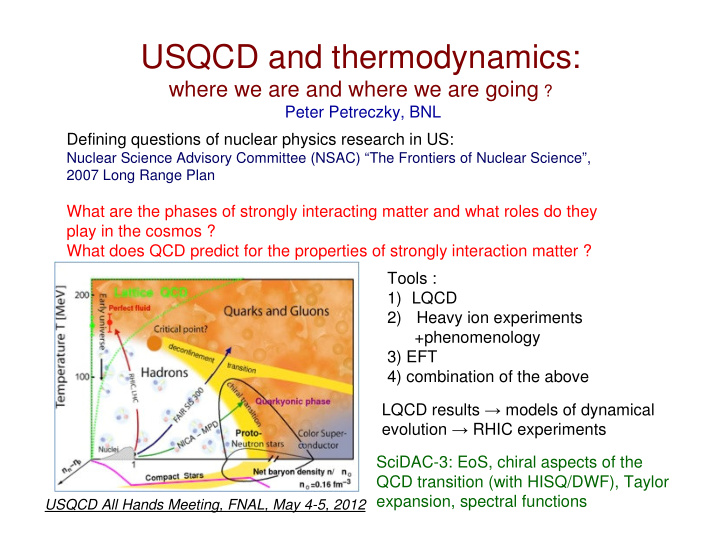



USQCD and thermodynamics: where we are and where we are going ? Peter Petreczky, BNL Defining questions of nuclear physics research in US: Nuclear Science Advisory Committee (NSAC) “The Frontiers of Nuclear Science”, 2007 Long Range Plan What are the phases of strongly interacting matter and what roles do they play in the cosmos ? What does QCD predict for the properties of strongly interaction matter ? Tools : 1) LQCD 2) Heavy ion experiments +phenomenology 3) EFT 4) combination of the above LQCD results → models of dynamical evolution → RHIC experiments SciDAC-3: EoS, chiral aspects of the QCD transition (with HISQ/DWF), Taylor expansion, spectral functions USQCD All Hands Meeting, FNAL, May 4-5, 2012
Physics of heavy ion collisions and LQCD Chiral transition, T c fluctu- high temperature QCD ations of conserved weak coupling ? charges EoS, viscosity EM and heavy flavor probes test of Hadron Resonance Gas (HRG) using LQCD quarkonium spectral functions, heavy quark diffusion, thermal dileptons
Structure of thermo LQCD community and USQCD proposals MILC (HEP) RBC (HEP) LANL & LLNL staggered thermo DWF thermo non- USQCD resources non-USQCD resources HotQCD USQCD non-USQCD resources Others: DWF and staggered smaller allocations/exploratory BNL (NP) work thermo USQCD resources H. Meyer, A. Li, A. Alexandru, D. Mehta non-USQCD resources USQCD proposal 2011/2012 (time requested in M J/psi core h and GPU node h) : HotQCD (PI A. Bazavov) EoS calculations : BG/P (INCITE), 17M, USQCD clusters, 15M BNL (PI H.T. Ding) Universal Behavior of the chiral transition : USQCD clusters, 40M BNL (PI S. Mukherjee) Taylor Expansion : GPUs in JLab, 1400K Y. Maezawa (type B proposal) Spatial meson correlators : USQCD clusters, 2.1M D. Mehta (type B proposal) Shear viscosity in 2-flavor QCD : USQCD clusters, 2.5M
Status of the EoS calculations Ongoing project on INCITE resources (BG/P in ANL) and USQCD cluster in FNAL LQCD based parametrization of the EoS used in most of hydro models for HIC
What is the transition temperature ? T c determination requires the study of the chiral transition as function of the quark mass (now HISQ, later DWF): HotQCD: Bazavov et al, Phys. Rev. D85 (2012) 054503 How well is the regular part is under controll, need smaller m l ? USQCD Proposal by H.T. Ding: down to m l =m s /80 ⇒ crucial for understanding the transition at non-vanishing baryon density, T c ( � ) Can be staggered formulation be trusted ? ⇒ DWF on larger lattices in the future proper treatment of axial anomaly
QCD thermodynamics at non-zero chemical potential Taylor expansion : hadronic quark BES @ RHIC Taylor expansion coefficients give the fluctuations and correlations of conserved charges, e.g. can be done very effectively on single GPUs (ongoing project by Mukherjee)
Spatial and temporal correlators • Temporal and spatial correlation functions are related to meson properties and transport coefficients Chiral symmetry: Onset of deconfinement: low/intermediate mass dilepton rate charmonium melting HotQCD, DWF BNL, p4 J/ ψ melting at T>300 MeV near term future : more detail study using HISQ action (Y. Maezawa, type B proposal ) • quark contribution to the energy-momentum correlator => shear viscosity in QCD ( D. Mehta type-B proposal 2012 )
Conclusions Lattice QCD starts to provide quantitative results that provide important input for interpreting the experimental results from HIC T c , EoS, fluctuation of conserved charges, spectral functions How sensitive is the QCD transition at physical quark masses to the universal properties in the chiral limit ? How the transition is modified by baryon chemical potential ? How the hadronic spectral functions are modified when T is increased ? Are the transport coefficients of QCD are closer to the weakly or strongly interacting picture ? Use improved staggered fermions to achieve sufficiently small lattice spacing and large N τ Use chiral fermions to control the symmetries of QCD
Recommend
More recommend